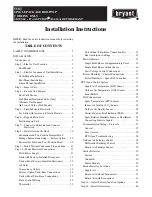
11
5. Open the filter clips which are located underneath the
hood top. Insert the aluminum filter into the bottom
filter rack (hood divider). Push the filter into position
past the open filter clips. Close the filter clips to lock
the filter into place. See Fig. 11.
6. Caulk the ends of the joint between the unit top panel
and the hood top.
7. Replace the filter access panel.
DIVIDER
BAROMETRIC
RELIEF
CLEANABLE
ALUMINUM
FILTER
FILTER
HOOD
FILTER
CLIP
OUTSIDE
AIR
C08634
Fig. 11 -- Economizer Filter Installation
Step 9 — Install External Condensate Trap
and Line
The unit has one
3
/
4
-in. condensate drain connection on
the end of the condensate pan and an alternate connection
on the bottom. See Fig. 12. Unit airflow configuration
does not determine which drain connection to use. Either
drain connection can be used with vertical or horizontal
applications.
DRAIN
(FACTORY-INSTALLED)
PLUG
CONDENSATE PAN (SIDE VIEW)
STANDARD
SIDE DRAIN
ALTERNATE
BOTTOM DRAIN
C08021
Fig. 12 -- Condensate Drain Pan (Side View)
When using the standard side drain connection, ensure the
red plug in the alternate bottom connection is tight. Do this
before setting the unit in place. The red drain pan plug can
be tightened with a
1
/
2
--in. square socket drive extension.
To use the alternate bottom drain connection, remove the
red drain plug from the bottom connection (use a
1
/
2
--in.
square socket drive extension) and install it in the side
drain connection.
The piping for the condensate drain and external trap can
be completed after the unit is in place. See Fig. 13.
NOTE: Trap should be deep enough to offset maximum unit static
difference. A 4” (102) trap is recommended
.
MINIMUM PITCH
1” (25mm) PER
10’ (3m) OF LINE
BASE RAIL
OPEN
VENT
TO ROOF
DRAIN
DRAIN PLUG
ROOF
CURB
SEE NOTE
2
˝
(51) MIN
C08022
Fig. 13 -- Condensate Drain Piping Details
All units must have an external trap for condensate
drainage. Install a trap at least 4-in. (102 mm) deep and
protect against freeze-up. If drain line is installed
downstream from the external trap, pitch the line away
from the unit at 1-in. per 10 ft (25 mm in 3 m) of run. Do
not use a pipe size smaller than the unit connection
(
3
/
4
-in.).
Step 10 — Make Electrical Connections
ELECTRICAL SHOCK HAZARD
Failure to follow this warning could result in personal
injury or death.
Unit cabinet must have an uninterrupted, unbroken
electrical ground to minimize the possibility of
personal injury if an electrical fault should occur. This
ground may consist of electrical wire connected to
unit ground lug in control compartment, or conduit
approved for electrical ground when installed in
accordance with NEC; ANSI/NFPA 70, latest edition
(in Canada, Canadian Electrical Code CSA [Canadian
Standards Association] C22.1), and local electrical
codes.
!
WARNING
NOTE
: Field--supplied wiring shall conform with the
limitations of minimum 63
_
F (33
_
C) rise.
Field Power Supply —
If equipped with optional Powered Convenience Outlet:
The power source leads to the convenience outlet’s
transformer primary are not factory connected. Installer
must connect these leads according to required operation
of the convenience outlet. If an always--energized
convenience outlet operation is desired, connect the
source leads to the line side of the unit--mounted
disconnect. (Check with local codes to ensure this method
is acceptable in your area.) If a de--energize via unit
disconnect switch operation of the convenience outlet is
desired, connect the source leads to the load side of the
unit disconnect. On a unit without a unit--mounted
disconnect, connect the source leads to compressor
558J



























